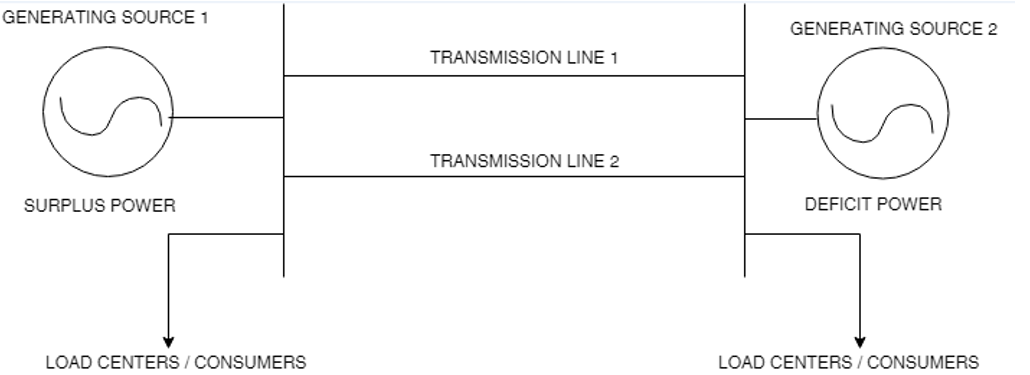This set of FACTS Multiple Choice Questions & Answers (MCQs) focuses on “Power Flow in AC Power System”.
1. In absence of any proper control, what will happen to the power transmission system delivering loads through two parallel paths, being connected to two generation areas, one having surplus generation and another with shortfall of power?

a) Both transmission lines will always share load equally
b) Both transmission line will never share load
c) Transmission line with lower impedance is likely to get overloaded
d) Transmission line with higher impedance is likely to get overloaded
View Answer
Explanation: Power always chooses the low impedance path to flow in a circuit as its characteristic feature. Therefore, in absence of any control on power-flow in a power transmission system, the transmission line with lower impedance will likely to get overloaded. In a power transmission system, electric power-flow is proportional to inverse of transmission line impedance of transmission lines.
2. Prior to introduction of SVCs, powerful gapless metal oxide arresters were used to limit dynamic over voltages in power system.
a) True
b) False
View Answer
Explanation: Prior to introduction of SVCs, powerful gapless metal oxide arresters were in practice. They were intended for limiting dynamic over voltages in power system. Also static-saturable-reactors were in use for limiting over-voltages.
3. Preceding SVCs, static-saturable-reactors were used to limit over voltages in power system.
a) True
b) False
View Answer
Explanation: Preceding the era of SVCs, powerful gapless metal oxide arresters and two versions of static-saturable-reactors were in practice. The former was intended for limiting dynamic over voltages in power system and he later was in use for limiting over-voltages.
4. In a power transmission system in absence of any control on power-flow, the electric power-flow is proportional to inverse of ________ of transmission lines.
a) transmission line impedance
b) transmission line resistance
c) transmission line capacitance
d) transmission line inductance
View Answer
Explanation: In a power transmission system in absence of any control on power-flow, the electric power-flow is proportional to inverse of transmission line impedance of transmission lines. Power always chooses the low impedance path to flow in a circuit as its characteristic feature. Therefore, in nonexistence of any control on power-flow in a power transmission system, the transmission line with lower impedance will likely to get overloaded.
5. A current source can be considered as a voltage source with the ________ source impedance.
a) different
b) same
c) same or different
d) zero
View Answer
Explanation: A current source can be considered as a voltage source with the same source impedance. So is true for a voltage source. This duality is mirrored in the concepts of Norton’s and Thévenin’s theorems.
6. In three phase power flow with star connection, line value of voltage is ________ phase value of voltage.
a) \(\sqrt3\) times
b) 1/\(\sqrt3\) times
c) equal to
d) 2/\(\sqrt3\) times
View Answer
Explanation: In three phase power flow with star connection, line value of voltage is equal to \(\sqrt3\) times of phase value of voltage. Again, for star connection, line value of current is equal to phase value of current.
7. In three phase power flow with star connection, line value of current is ________ phase value of current.
a) \(\sqrt3\) times
b) 1/\(\sqrt3\) times
c) equal to
d) 2/\(\sqrt3\) times
View Answer
Explanation: In three phase power flow with star connection, line value of current is equal to phase value of current. Again, for star connection, line value of voltage is equal to \(\sqrt3\) times of phase value of voltage.
8. In three phase power flow with delta connection, line value of voltage is ________ phase value of voltage.
a) \(\sqrt3\) times
b) 1/\(\sqrt3\) times
c) equal to
d) 2/\(\sqrt3\) times
View Answer
Explanation: In three phase power flow with delta connection, line value of voltage is equal to phase value of voltage. Again for delta connection, line value of current is equal to \(\sqrt3\) times of phase value of current.
9. In three phase power flow with delta connection, phase value of current is ________ line value of current.
a) \(\sqrt3\) times
b) 1/\(\sqrt3\) times
c) equal to
d) 2/\(\sqrt3\) times
View Answer
Explanation: In three phase power flow with delta connection, phase value of current is equal to 1/\(\sqrt3\) times of line value of current. Again for delta connection, line value of voltage is equal to phase value of voltage.
10. In three phase power flow, the equation P = \(\sqrt3\)VLILcos θ suggests _______
a) three phase balanced load
b) three phase unbalanced load
c) two phase balanced load
d) two phase unbalanced load
View Answer
Explanation: In three phase power flow, the equation P = \(\sqrt3\)VLILcos θ suggests three phase balanced load because in unbalanced condition of power flow, this equation does not hold good. In case of balanced loads, the phase currents or voltages are equal and displaced by exactly 120°, exhibiting only positive-sequence components. On the contrary, in case of unbalanced loads, a current or voltage unbalance between phases in magnitude or phase angle generally gives rise to negative and zero-sequence components.
Sanfoundry Global Education & Learning Series – Flexible AC Transmission System (FACTS).
To practice all areas of Flexible AC Transmission System (FACTS), here is complete set of 1000+ Multiple Choice Questions and Answers.
If you find a mistake in question / option / answer, kindly take a screenshot and email to [email protected]
